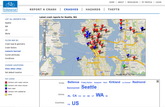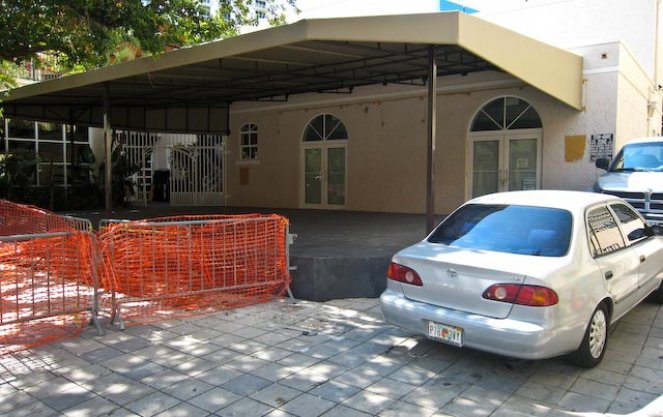Whenever anyone asks me why I like Twitter so much, I tell them it’s about the information. If you follow the right people (and who that is obviously depends entirely on you) you can tap into an amazing amount of great stuff from around the Internet (and real life too). It’s like having a custom-made news feed filtered through some very intelligent, and idiosyncratic, human brains.
 Yesterday, one of the people we follow on the Streetsblog Network Twitter account, @zaneselvans, let us know via Twitter about a very cool project from the Cascade Bicycle Club called Bikewise. The site collects and maps user-generated reports of bike crashes, hazards and thefts from around the country:
Yesterday, one of the people we follow on the Streetsblog Network Twitter account, @zaneselvans, let us know via Twitter about a very cool project from the Cascade Bicycle Club called Bikewise. The site collects and maps user-generated reports of bike crashes, hazards and thefts from around the country:
We started bikewise in the conviction that we could make biking safer and more fun by gathering good data on the things that sometimes go wrong.
Crashes: It’s estimated that 75% or more of all crashes go unreported. We believe that by gathering detailed information on how and why crashes happen, we’ll be able to ride smarter. Also, we hope that knowing where crash hotspots are will help us to identify issues with traffic behavior and road design.
Hazards: How many times have you ridden past a dangerous sewer grate or overgrown vegetation and wished there were someplace to report it? Now there is. We aim to not only collect hazard reports, but to pass these on to the appropriate authorities. (Please note: we’re still putting this part of the system in place.)
Thefts: Tracking where and how bikes get stolen is a key part of making preventing thefts. We’re currently working on other pieces of this system, so that if your bike does get stolen, you have a better chance of getting it back. More to come on that.
Obviously, such a site is only as good as the information it collects and what is done with it once it’s in the system. The SeeClickFix service has demonstrated that this kind of software initiative can help local governments get problems solved. Bikewise’s success will depend on the participation of people who are committed to improving biking conditions, and interested in the possibilities of the Internet-based hive mind. Maybe you’re one of them.
Another news flash from Twitter: @USDOT is on, as of yesterday. We’re happy to report that we were one of the first three follows they made. The other two were @T4America and @whitehouse.
Cross-posted from Streetsblog.

The owner of this property in Miami has decided to convert a parking lot to a terrace.
Today’s post, from Streetsblog Network member Urban City Architecture, gives an example of how—by converting a small parking lot to a terrace—one business owner in Miami’s Brickell neighborhood is contributing to an increasingly vital streetscape:
It seems that recent development and new emphasis on the pedestrian landscape has encouraged a property owner in Brickell to replace a small surface (parking) lot in front of a building with more pedestrian-oriented and occupiable urban space fronting the sidewalk instead. Over the last couple of months, workers have been busy transforming the old parking spaces into an elevated outdoor seating space for what I presume will be a restaurant (or expansion of the existing restaurant next door).
In essence, the integration of the building within the urban fabric has been reconfigured to make it more responsive to pedestrians and more fitting with its surroundings. Prior to these changes, the building?s parking layout served as a physical and visual barrier between the pedestrian and the building. Much in the same way that buildings are setback behind inhospitable and unwalkable parking in the suburbs—pedestrians walking the streets were not greeted by a building facade or window but rather by a long row of car exhausts and vehicle bumpers that contribute nothing to the urban atmosphere.
Luckily, the transformation of the space will change this unfavorable dynamic and create a more lively and active environment on the streets.
It’s part of a process that the post’s author, Adam Mizrahi, likes to call “automobile attrition.” And it’s an intriguing example of how, when a neighborhood achieves some livable streets momentum, the dead space created by cars and parking becomes more apparent.
More from around the network: Newton Streets and Sidewalks talks about how more roads don’t ease congestion; Urban Milwaukee has a personal story about how senior citizens can get shut out of walkable neighborhoods; and The Infrastructurist looks at why Hawaii got complete streets legislation and Missouri didn’t.
Cross-posted from Streetsblog.
This morning, Jeff Wood at The Overhead Wire points us to a newly released measure of CO2 emissions from the Center for Neighborhood Technology (which just won a 2009 MacArthur Foundation Award for Creative and Effective Institutions, BTW). He says maps like these help to show why changing land-use patterns is vital in the fight to diminish greenhouse gases:
CNT has released another Affordability Index update that shows transportation emissions is 70% less in cities than in the suburbs. Why is this? Because people don’t have to drive as much. You can see already the benefits, and it isn’t all about electric cars. Yet some in Southern California think that SB375, the landmark climate change bill, can be addressed with electric cars alone. Sorry guys. It doesn’t work like that.?
But it’s not just transportation, it’s building as well. We need to look at this as a complete system. This singular focus on one method is somewhat maddening. I know there are a lot of people who are hoping for a magic green car or a magic green building but we’re also forgetting our water usage and population growth among other things.
The CNT site has some very cool maps that compare not only CO2 emissions from household auto use per acre and per household, but also the cost of housing and transportation as a percentage of average household income in many regions across the country.
As The Overhead Wire points out, maps like these point out the importance of development patterns in limiting emissions, and the reality that only a holistic solution will make a dent. Zero-emissions vehicles aren’t going to solve the nation’s carbon bloat any more than a diet pill can provide a long-term solution for an obese individual.
Other fun stuff from around the network: Brooklyn by Bike protests the girlification of women’s bikes (stop the flowers!); Cyclelicious has the news that French prisoners get to participate in their own Tour de France; and World Streets has data that suggests that swine flu killed more people with traffic fatalities in Mexico City than with germs.
Cross-posted from Streetsblog.